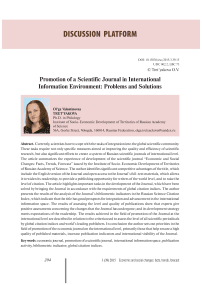Promotion of a scientific journal in international information environment: problems and solutions
Автор: Tretyakova Olga Valentinovna
Журнал: Economic and Social Changes: Facts, Trends, Forecast @volnc-esc-en
Рубрика: Discussion platform
Статья в выпуске: 3 (39) т.8, 2015 года.
Бесплатный доступ
Currently, scientists have to cope with the tasks of integration into the global scientific community. These tasks require not only specific measures aimed at improving the quality and efficiency of scientific research, but also significant efforts to create a system of Russian scientific journals of international level. The article summarizes the experience of development of the scientific journal “Economic and Social Changes: Facts, Trends, Forecast” issued by the Institute of Socio-Economic Development of Territories of Russian Academy of Science. The author identifies significant competitive advantages of the title, which include the English version of the Journal and open access to the Journal's full-text materials, which allows it to widen its readership, to provide a publishing opportunity for writers of the world level, and to raise the level of citation. The article highlights important tasks in the development of the Journal, which have been solved by bringing the Journal in accordance with the requirements of global citation indices...
Economic journal, promotion of a scientific journal, international information space, publication activity, bibliometric indicator, global citation indices
Короткий адрес: https://sciup.org/147223729
IDR: 147223729 | УДК: 002.2 | DOI: 10.15838/esc/2015.3.39.15
Текст научной статьи Promotion of a scientific journal in international information environment: problems and solutions
The increasing role of scientific journals both in the development of academic science, in general, and in the identification of key research priorities determines the emergence of issues related to the promotion of academic publications in the international information space.
The need for more objective information about publications of Russian scientists and improved transparency of Russian science and technology in the world, primarily by global citation indices Web of Science (WoS) and Scopus, has aroused interest in the task of expanding presence of Russian journals in these indices [2, 3, 6–8, 10–13, 17, 20, 23, 26–30].
The targets on the share of publications in international databases are set out in government documents. In order to improve the state policy in the field of education and science and the training of qualified specialists with regard to the requirements of innovative economy, the President urged the Government “to ensure the increase in the share of Russian researchers’ publications in the total number of publications in international scientific journals, indexed in the database “Web of Science” to 2.44 percent by 2015”1. In 2014 the share of Russian researchers’ articles in scientific journals, indexed in the Web of Science database, was recorded at 2.11%, or
29,793 units (as of the beginning of April, 2015) [15, p. 112]. However, by share of publications in the WoS database, Russia is still noticeably inferior to the countries-leaders, as well as to the considerable number of countries, following the path of catching-up development ( fig. 1 ).
It should be emphasized that the citation of Russian authors remains too low. So, only in recent years the indicator of citation impact, calculated as average citation in InCites, expressed as percentage of the average for the world (equal to 1), has been approaching the value of 0.5, i.e. 2-fold lower than the average world indicator. Foreign experts note that the citation impact of Russian publications is one of the lowest among the indicators of the Eastern Europe countries [27, p. 1113].
According to experts, the achievement of “readability” and “citation” of Russian publications is possible, if the quality of publications and journals, in general, is in compliance with international standards. The producers and experts of international databases rely on them when selecting journals for indexing in these resources [Kirillova, 2014].
The number of Russian scientific journals indexed in Web of Science increased in 2006–2012, although since 2012 this trend has begun to decline ( fig. 2 ). As of May 2015, 159 Russian journals are indexed in WoS [24]. Besides, more than half of the scientific articles are published in Russian journals ( fig. 3 ).
As the significant percentage of articles is published in Russian journals, scientists are to increase the number of publications
Figure 1. Share of publications in the international system Web of Science, % (WoS data, May 2015)
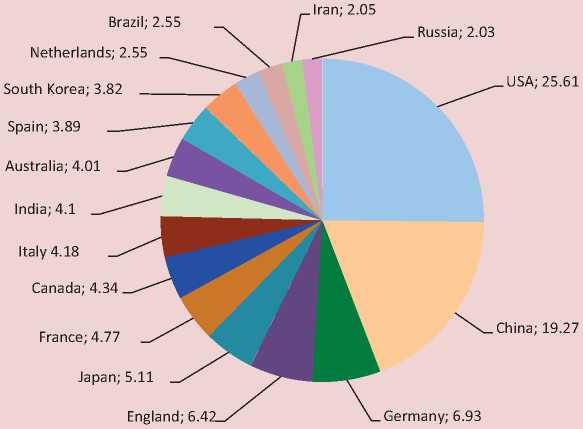
Figure 2. Number of Russian scientific journals indexed in the international system Web of Science, units (data as of May 2015)
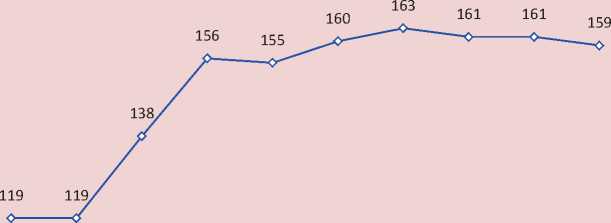
2006 2007 2008 2009 2010 2011 2012 2013 2014 2015
Figure 3. Dynamics of the share of Russian authors’ articles published in Russian journals indexed in the international system Web of Science, %

48 ' 2OOS ' 2 ■ ' 2OO2 ' 2OOS ' 2OO, ' »!, »!, »!, in the global citation indices, it is very important to raise the number of such journals. However, the analysis of modern requirements for the number of researchers’ publications and its correlation with the number of journals indexed in WoS and Scopus reveals the excess of the demand in publications over the possibilities of journals to satisfy them. To solve the problem, scientists propose to publish Russian scientific journals in two languages, with international editorial boards [1, p. 79].
In our opinion, the editorial boards of journals should first and foremost focus on bringing scientific journals in accordance with international publishing standards and demands of international citation indices. This path is chosen by the journal “Economic and Social Changes: Facts, Trends, Forecast”, founded and published by the Institute of Socio-Economic Development of Territories of the RAS.
The significant competitive advantage of the Journal is the presence of its full-text English version, published since 2009. Thus, we can speak about a 6-year history of the English-language version. The translation is done by in-house translators. The level and quality of translation has been repeatedly highly assessed by foreign members of the Journal’s Editorial Board.
The task for the Journal to join the international citation databases Scopus and Web of Science should become an important step in its promotion. The Editorial Staff consistently pursues appropriate policies. In 2013–2014 the staff conducted a number of activities aimed at bringing the Journal to a new level that complies with the requirements of international standards.
The work to develop and promote the Journal is carried out in the following directions:
-
1. Ensuring the quality of the Journal, including its international visibility.
-
2. Formation of stable distribution channels.
-
3. Increasing visual appeal and visualization of the Journal for authors and readers.
-
4. Bringing the Journal in full compliance with the requirements of global citation indices.
The Journal is focused on:
-
1. Creating a highly experienced group of specialists to select articles:
– strengthening the Editorial Board by attracting foreign scientists with high citation metrics in foreign databases;
– extending the number of reviewers by attracting respected Russian and foreign experts for the evaluation of scientific papers.
-
2. Attracting domestic and foreign authors who are recognized experts in the problems of modernization, regional and sectoral economic, social and innovative development and general theoretical and methodological issues.
-
3. Restructuring the Journal in accordance with the requirements of foreign databases.
-
4. Increasing the availability and transparency of the Journal in Russia and abroad:
-
– provision of free access to the Journal’s full-text version on the website;
-
– submission of the Journal to the largest libraries;
-
– inclusion of the Journal in Russian and foreign databases.
The first measures involved the enhancement of quality of the articles according to the requirements of foreign databases. So, the requirements for manuscripts submitted to the Editorial Board of the Journal were updated. The requirements for abstracts in the article were changed: the volume of abstracts was raised up to 1800 characters (200–250 words). Their structure was enhanced: the blocks, such as introduction, objectives and tasks, methodology, results, conclusion, are to be included now. The Journal was brought in accordance with the requirements of foreign databases: in the Russian version of the Journal abstracts are in English; data on author affiliation are transferred into the body of an article; references are in the Roman alphabet; data on affiliation of the Editorial Board members are supplemented; the International Standard Serial Number (ISSN) for the online version of the Journal is acquired. Table 1 presents the results of estimated compliance of the Journal with the requirements of global citation indices.
Table 1. Assessed conformity of the Journal “Economic and Social Changes: Facts, Trends, Forecast” to the requirements of international systems of citation
|
Indicators |
Conformity assessment |
|
Presence of ISSN |
The journal is registered in the ISSN International Center; there are separate ISSNs for Russian and English versions, as well as for print and online versions. |
|
Compliance of periodicity of the publication and the stated volume |
The journal is published 6 times a year strictly according to the schedule; the declared issue volume is 230–250 pages. |
|
Stable review system |
All research articles are subject to peer-review and expert selection; the double-blind peerreview is used; the information on requirements for peer-review is posted on the journal’s website; the database of external experts is maintained. |
|
Sound editorial policy |
The editorial policy formulated and presented in the Journal and on its website is determined by the orientation on a specific audience and a subject area and the pursuit of novelty, relevance and uniqueness of the publication. |
|
Presence of the declaration of conformity to publication ethics |
The regulations on publication ethics are posted on the journal’s website. |
|
High scientific level of the editorial board, sufficient international composition |
The Editorial Board currently includes 23 leading Russian and foreign scientists: academicians and RAS corresponding members, Doctors of Sciences, heads of a number of RAS institutes, academicians of the NAS of Belarus and scientists from France, Finland, Poland and China. |
|
Rather broad geography of authors |
The share of foreign authors, on average, amounts to 70%; there are publications of authors from 8 federal districts, 2 cities of federal importance and more than 20 regions of the Russian Federation. The international team of authors is expanded every year. |
|
Presence of a website of the scientific journal |
The Journal’s website is in Russian and in English, presenting full information about the edition and full-text archives of all editions. |
|
Quality of printing |
High printing and digital quality of the publication is provided by the presence of a developed material and technological base for the implementation of prepress and replication of the Journal (private printing-house, developed information technologies). |
In May 2014, at the suggestion of the Editorial Board member J. Sapir, the English-language version of the Journal was sent to a number of foreign national libraries with a request to evaluate content, subject matter and level of articles and consider the possibility for inclusion in library collections. As a result, the German National Library of Economics and the Library of Congress receive the Journal on a regular basis now.
The great work was carried out to join Russian and foreign databases. The journal is indexed in Russian Science Citation Index (RSCI), present at the international information systems, such as Ulrich’s Periodicals Directory, Index Copernicus, Google Scholar, and the international databases, such as EBSCOhost, ProQuest and
RePEC. May 2, 2015 the Journal “Economic and Social Changes: Facts, Trends, Forecast” was included into the largest international base of open access journals DOAJ (Directory of Open Access Journals). The inclusion in this database indicates the quality of the Journal.
In the analyzed journal articles are published by Russian scientists in the field of Economics and Sociology, among them there are academicians and RAS Corresponding Members, Doctors of Sciences, and associates with a Ph.D., research associates without a degree and postgraduate students. In 2008–2014 4.3% of the Journal publications belongs to academicians and RAS corresponding members, 27.1% – Doctors of Sciences,
Figure 4. Authors published in the Journal “Economic and Social Changes: Facts, Trends, Forecast” in 2008–2014
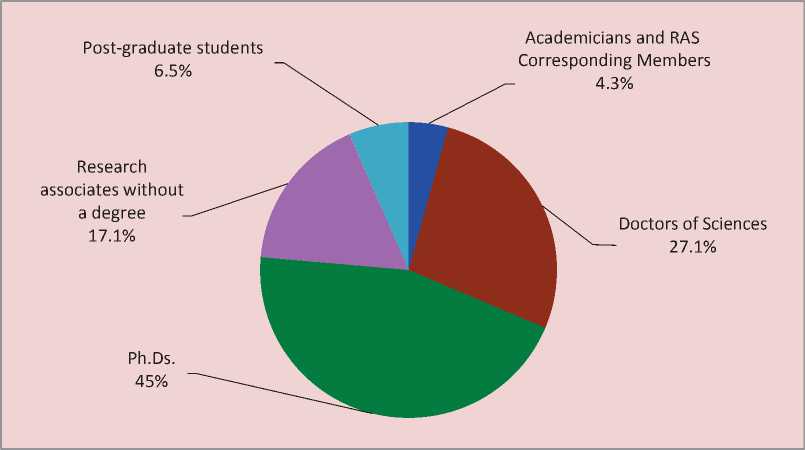
45% – associates with a Ph.D., 17.1% – research staff without a degree and 6.5% – post-graduate students ( fig. 4 ).
In 2014 the Journal published 115 research articles ( tab. 2 ). The subject matter of publications is relevant to the priority areas of fundamental and applied research in the field of economic knowledge. The grown number of published articles indirectly reveals a systematic increase in the number of studies and the research activity.
The Journal is characterized by a large group of authors. Its international membership is increasing yearly. The period under analysis observed the works of scientists from
China, Poland, France, Finland, Czech Republic, Azerbaijan, Belarus, Latvia, Lithuania, Kazakhstan and Ukraine. The share of foreign articles in the last three years amounted to more than 10% of the total number of publications of the Journal. The geography of Russian authors is steadily expanding ( tab. 3 ).
Judging by the figures for 2008 and 2014, i.e. the first and last periods of the Journal publication, there was a 3-fold increase in the representation of federal districts (from 3 to 10, respectively) and a 2-fold rise in the representation of RF subjects (from 7 to 19) ( fig. 5 ).
Table 2. Dynamics of the number of scientific articles published in the Journal “Economic and Social Changes: Facts, Trends, Forecast” in 2008–2014
|
Indicator |
2008 |
2009 |
2010 |
2011 |
2012 |
2013 |
2014 |
|
Total number of articles – per year |
41 |
48 |
56 |
95 |
106 |
99 |
115 |
|
Number of articles per issue |
10.25 |
12.0 |
14.0 |
15.8 |
17.7 |
16.5 |
19.2 |
Table 3. Dynamics of the number of RF subjects and federal districts*, the authors of which published articles in the Journal “Economic and Social Changes: Facts, Trends, Forecast” in 2008-2014
|
Indicator |
2008 |
2009 |
2010 |
2011 |
2012 |
2013 |
2014 |
|
Number of RF subjects |
7 |
8 |
8 |
10 |
15 |
15 |
19 |
|
Number of federal districts |
3 |
3 |
5 |
6 |
7 |
6 |
10 |
|
* Including the cities of federal significance. |
|||||||
Expanding geography of the authors suggests that the Journal “Economic and Social Changes: Facts, Trends, Forecast” is gradually gaining recognition in the Russian scientific community. At the same time, it has acquired its readership. The demand for the Journal is indirectly confirmed by the analysis of scientometric indicators of the Journal in the Russian Scientific Citation Index.
There are basic scientometric indicators for evaluating a scientific journal, such as an impact factor proposed by the American scholar Eugene Garfield as a tool to measure the value of journals by calculating the average number of citations to an article for a certain period of time [25, 1955].
We previously expressed our view on the application of an impact factor as a tool for ranking scientific journals and presented an overview of existing methods for this index formation [19, 2014]. To make the situation more vivid, let us note that the traditional method is to calculate a two-year impact factor of a journal. The two-year impact factor is a classic indicator, calculated by the most authoritative database Web of Science and recognized throughout the world as the basis for ranking journals in relation to each other. “The classic impact factor, i.e. what we natively understand under this term, – says Vladimir Polyakov, is in the strict sense a simultaneous two-year impact factor; the current year is not taken into account... it is an impact-factor that in our time is most often mentioned when comparing the level of the journals” [16, p. 131].
In the Russian Science Citation Index the impact factor is calculated according to the citation of a journal in the Russian Science Citation Index for the previous 2 years – IF2 (or 5 years – IF5). The data on citations are taken from publications of the year for which the impact factor is calculated. To calculate the impact factor, of all journals processed in the Russian Science Citation Index the number of references made in the estimated year to articles published in this journal during the previous 2 years (or 5 years), divided by the total number of these articles. In fact, this indicator reflects the average number of citations to articles in a journal. There is a necessary condition for the calculation of a two-year impact factor, such as the presence of all editions of Journal for 3 years (a year of the impact factor calculation plus 2 previous years)2.
The data, reflecting the dynamics of impact factor values of the Journal
Figure 5. Geography of Russian authors of the Journal “Economic and Social Changes: Facts, Trends, Forecast” in 2008–2014
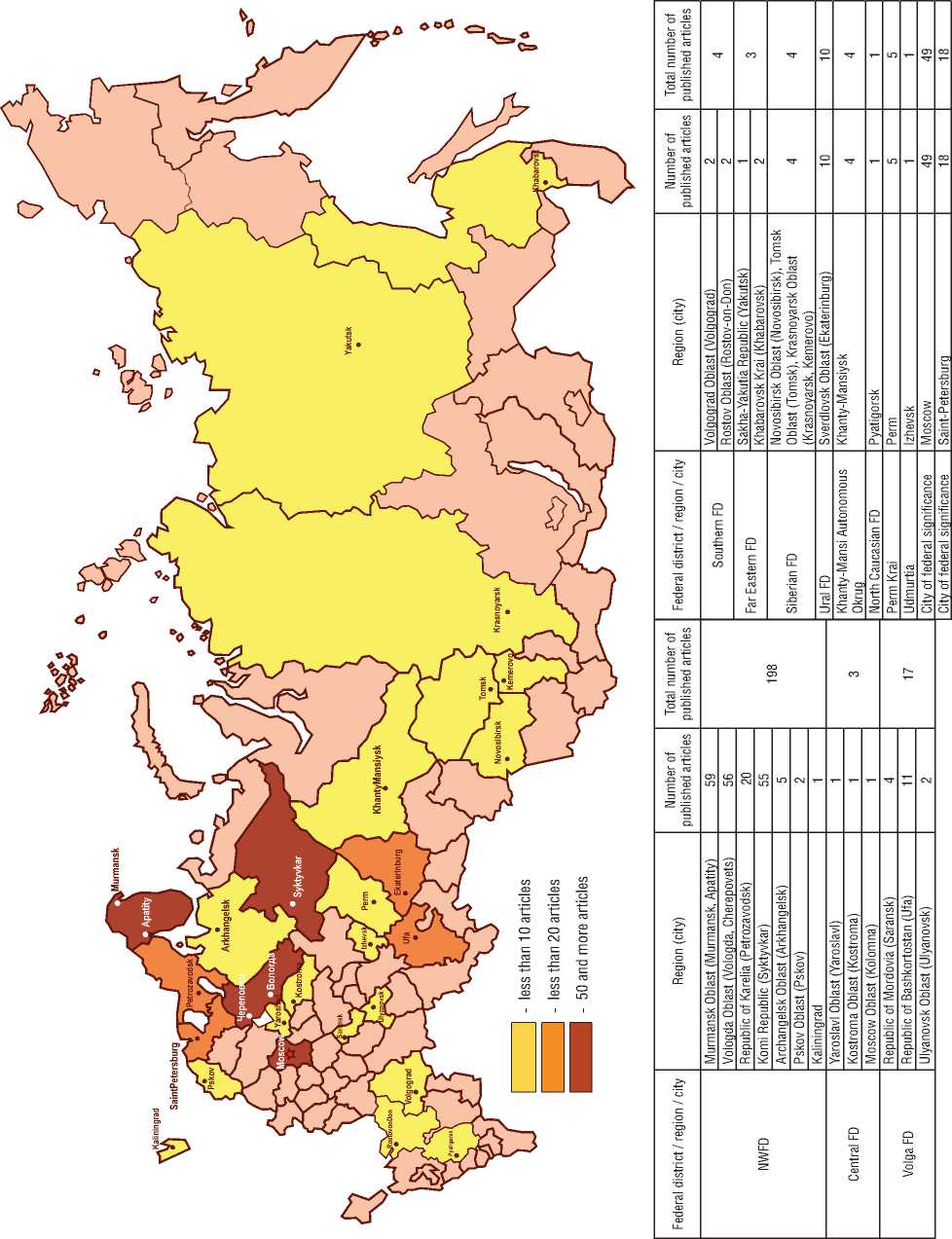
“Economic and Social Changes: Facts, Trends, Forecast” in the RSCI for the 2009–2014 period, is presented in Figure 6 .
The indicators shown in Figure 7 reveal a systematic increase in all values of the impact factor of the Journal. So, in 2014
Figure 6. Impact factor of the Journal “Economic and Social Changes: Facts, Trends, Forecast” in the RSCI (eLIBRARY data as of April 27, 2015)
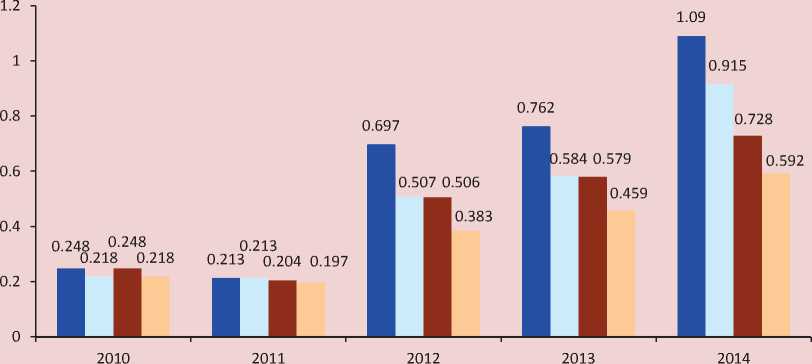
■ 2-year impact-factor of RSCI
2-year impact-factor of RSCI without self-citation
■ 5-year impact-factor of RSCI
■ 5-year impact-factor of RSCI without self-citation
Figure 7. Dynamics of the impact factor values of the Journal “Economic and Social Changes: Facts, Trends, Forecast” in the RSCI (eLIBRARY data as of April 27, 2015)
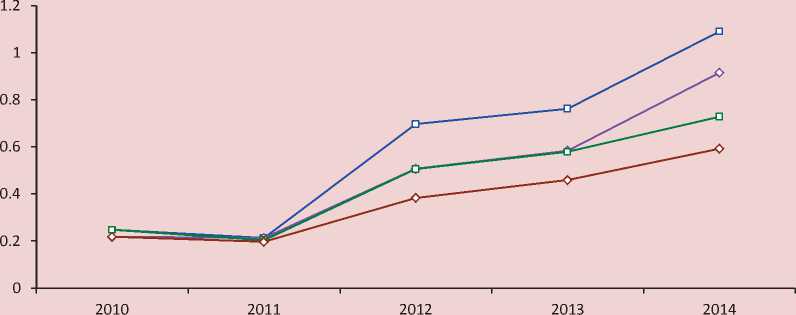
2-year impact-factor of RSCI
2-year impact-factor of RSCI without self-citation
5-year impact-factor of RSCI
5-year impact-factor of RSCI without self-citation
the growth rates are in the range of 29 to 57%. Compared with the 2009 level, IF2 increased 13-fold and IF5 – 3-fold.
It seems important that in 2012–2014 the coefficients of self-citation of the Journal decreased and the Herfindahl index values remain low (less than 1500). This suggests that the increase in the impact factor of the Journal is provided due to the citation in external sources, but not at the expense of self-citation or citation in a limited range of publications.
Two-year and five-year self-citation coefficients of the Journal in 2014 were less than 20% each ( fig. 8). This is a low level of citation. For comparison, 80% of the journals from the Web of Science database have a self-citation coefficient within 20% [22, p. 4].
To make the Journal assessment more objective, we present the dynamics of the Herfindahl index values ( fig. 9 ), which allows us to take into account the number of citing organizations and the number of institutions, the authors of which are published in the Journal.
The Herfindahl index is calculated as a sum of squares of the percentages of the number of articles published by various organizations in relation to the total number of articles in the journal in the current year in which the organization is identified. The index takes into account a number of citing journals and identifies groups of self-citation journals, the so-called self-citation clusters. The greater the number of organizations, the more even the distribution of publications among them,
Figure 8. Self-citation coefficient of the Journal “Economic and Social Changes: Facts, Trends, Forecast” in the RSCI (eLIBRARY data as of April 27, 2015)
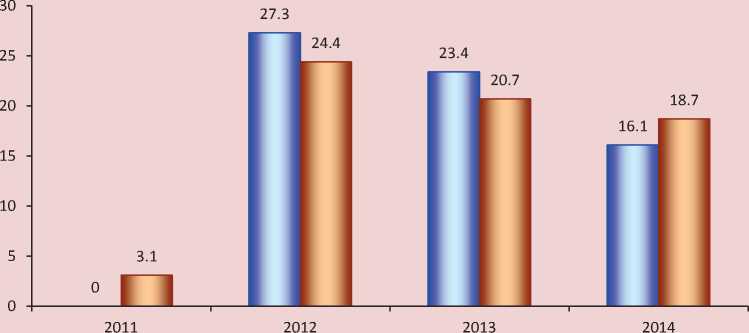
О 2-year self-citation coefficient
□ 5-year self-citation coefficient
Figure 9. Herfindahl index of the Journal “Economic and Social Changes: Facts, Trends, Forecast” in the RSCI (eLIBRARY data as of April 27, 2015)
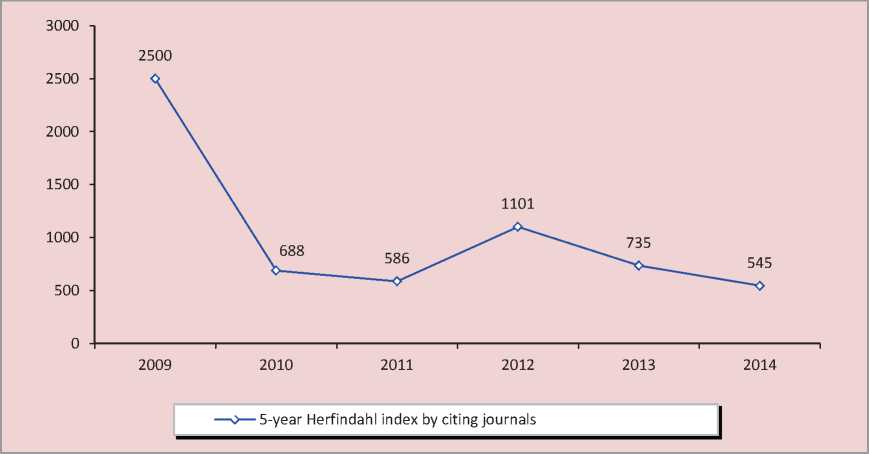
the smaller this indicator value. Its high value (more than 1500) suggests that the significant share of links belongs to a very limited number of other journals.
The Journal “Economic and Social Changes: Facts, Trends, Forecast” as of March 14, 2015 ranks 17th out of 300 economic journals and 3rd out of 58 sociological ones in the Russian Science Citation Index by a two-year impact factor for 2014. In the SCIENCE INDEX rating in the category “Economy. Economic science” in 2014 the Journal ranks 43rd out of 287 journals (tab. 4).
The integral index of a journal in the Science Index system is used to rate Russian scientific journals and is calculated by the following method. The index calculations are based on a five-year impact factor of a journal in the Russian Science Citation Index; the translated version of a journal (if any) and self-citation are taken into account. The calculated values of the 5-year impact factor of a journal are normalized
Table 4. Dynamics of the indicator and position of the Journal “Economic and Social Changes: Facts, Trends, Forecast” in the SCIENCE INDEX rating in the category “Economy. Economic science” in 2010–2014 (eLIBRARY data as of April 27, 2015)
According to Table 4, at the end of 2014 the Journal “Economic and Social Changes: Facts, Trends, Forecast” was in the top quartile of the SCIENCE INDEX rating in the category “Economy. Economic science”. Thus, it is possible to note that by scientometric indicators the Journal has high positions relative to other publications of the same theme. In general, the analysis of cientometric indicators of the Journal in the Russian Science Citation Index reveals that it has good starting conditions for integration and advancement in the international information space.
Annually the Institute of SocioEconomic Development of Territories of the Russian Academy of Sciences carries out expert estimation of the Journal “Economic and Social Changes: Facts, Trends, Forecast”. In 2014 the questionnaire was completed by the ISEDT RAS personnel, the Editorial Board and the Editorial Staff members, as well as the readers who receive it. The survey involved 114 respondents: 13 members of the Editorial Board and the Editorial Staff of the Journal, 13 readers and 88 employees of ISEDT RAS. The data on the dynamics of the number of respondents participating in the expert assessment are given in Table 5 .
The survey helps identify the assessment of the level and the quality of publications in the Journal and elaborate a number of proposals for improving its quality.
About 75% of the respondents assess changes in the Journal as positive, at about the same level as the previous year ( tab. 6 ). However, the proportion of respondents who have not noticed any major changes in the Journal has decreased slightly.
Table 5. Dynamics of the number of respondents participating in the expert assessment of the Journal “Economic and Social Changes: Facts, Trends, Forecast” in 2010–2014, persons
|
Group of respondents |
2010 |
2011 |
2012 |
2013 |
2014 |
Growth rate in 2014 compared to 2013, % |
|
Members of the Editorial Board and the Editorial Staff |
13 |
20 |
17 |
11 |
13 |
118 |
|
Employees of ISEDT RAS |
81 |
86 |
86 |
82 |
88 |
107 |
|
Readers |
- |
- |
- |
- |
13 |
- |
|
Total |
94 |
106 |
103 |
93 |
114 |
123 |
Table 6. Dynamics of the share of respondents answering the question:
“How would you assess the changes that have occurred in the Journal?”, in 2010–2014, %
|
Answer variant |
2010 |
2011 |
2012 |
2013 |
2014 |
Absolute deviation 2014 to 2013, % |
|
Positively |
83.0 |
84.0 |
78.5 |
77.7 |
74.6 |
-3.1 |
|
Negatively |
1.1 |
0.0 |
0.0 |
0.0 |
0.0 |
0 |
|
No significant changes |
4.2 |
7.5 |
7.5 |
16.5 |
14.9 |
-1.6 |
|
Difficult to answer |
11.7 |
8.5 |
14.0 |
5.9 |
10.5 |
+4.6 |
Table 7. Dynamics of the share of respondents answering the question: “How would you assess the level of materials published in the Journal?”, in 2010–2014, %
|
Answe r variant |
2010 |
2011 |
2012 |
2013 |
2014 |
Absolute deviation 2014 to 2013, % |
|
High |
25.5 |
23.6 |
22.6 |
25.9 |
26.3 |
+0.4 |
|
Rather high |
63.9 |
66.0 |
69.9 |
62.4 |
64.9 |
+2.5 |
|
Average |
10.6 |
9.4 |
6.5 |
9.4 |
8.8 |
-0.6 |
|
Below average |
0.0 |
0.0 |
0.0 |
0.0 |
0.0 |
0.0 |
|
Low |
0.0 |
0.0 |
0.0 |
1.2 |
0.0 |
-1.2 |
Table 8. Answer to the survey question: “What sections, in your opinion, are of the greatest interest”
|
Section |
2010 |
2011 |
2012 |
2013 |
2014 |
|
Mean score |
|||||
|
Social Development |
8.7 |
8.5 |
8.5 |
8.6 |
8.8 |
|
From the Chief Editor |
8.7 |
8.4 |
8.4 |
8.5 |
8.7 |
|
Development Strategy |
6.7 |
8.6 |
8.2 |
8.5 |
8.7 |
|
Regional Economy |
5.6 |
8.7 |
8.7 |
8.4 |
8.5 |
|
Innovation Development |
5.0 |
8.6 |
8.3 |
8.2 |
8.5 |
|
Young Researchers |
7.7 |
8.2 |
8.2 |
8.3 |
8.3 |
|
Social Finances |
2.6 |
8.1 |
8.1 |
8.0 |
8.3 |
The majority of the respondents (91.2%) assess the level of materials published in the Journal as high and rather high ( tab. 7 ).
Judging by the survey results, the readers and experts are most interested in the sections, such as “Social Development”, “Development Strategy”, “From the Chief Editor”, etc. ( tab. 8 ).
Today the Journal “Economic and Social Changes: Facts, Trends, Forecast” has 4 versions. Russian print and online versions remain most popular ( tab. 9 ).
Answering the questions about satisfaction of the work carried out by the Editorial Staff of the Journal in 2014, the respondents estimate it as high – 8.8 points (by the 10-point scale).
Table 9. Answer to the survey question:
“How popular, in your opinion, are different versions of the Journal?
|
Answer variant |
2010 |
2011 |
2012 |
2013 |
2014 |
Absolute deviation 2014 to 2013, % |
|
% of the total number of respondents |
||||||
|
Russian print version |
||||||
|
Very popular |
37.2 |
46.2 |
34.4 |
48.2 |
43.0 |
-5.2 |
|
Popular |
56.4 |
44.3 |
55.9 |
38.8 |
47.7 |
+8.9 |
|
A bit popular |
2.2 |
5.7 |
5.4 |
10.6 |
9.3 |
-1.3 |
|
Unpopular |
1.1 |
0 |
0.0 |
0.0 |
0.0 |
0 |
|
Russian online version |
||||||
|
Very popular |
58.5 |
62.3 |
46.2 |
57.6 |
50.9 |
-6.7 |
|
Popular |
31.9 |
31.1 |
44.1 |
35.3 |
46.2 |
+10.9 |
|
A bit popular |
5.3 |
1.9 |
4.3 |
3.5 |
1.9 |
-1.6 |
|
Unpopular |
0.0 |
0.0 |
1.1 |
0.0 |
0.9 |
+0.9 |
|
English print version |
||||||
|
Very popular |
3.2 |
3.8 |
5.4 |
4.7 |
10.1 |
+5.4 |
|
Popular |
26.6 |
34 |
25.8 |
40.0 |
25.3 |
-14.7 |
|
A bit popular |
50.0 |
42.5 |
44.1 |
30.6 |
47.5 |
+16.9 |
|
Unpopular |
18.1 |
13.2 |
18.3 |
16.5 |
17.2 |
+0.7 |
|
English online version |
||||||
|
Very popular |
9.6 |
12.3 |
10.8 |
9.4 |
19.6 |
+10.2 |
|
Popular |
31.9 |
47.2 |
43.0 |
42.4 |
40.2 |
-2.2 |
|
A bit popular |
36.2 |
28.3 |
28.0 |
30.6 |
29.9 |
-0.7 |
|
Unpopular |
11.7 |
6.6 |
10.8 |
10.6 |
10.3 |
-0.3 |
However, they make a number of proposals to improve the quality of reviewed publications, in particular: expand the range of marketing measures to promote the Journal in new regions and attract new audience of readers; more actively involve the Editorial Board members in the “real” work on the Journal (preparation and review of articles); continue the work on bringing the Journal in compliance with international standards; send the Journal to the governments of the Northwestern Federal District regions; encourage scientific discussions in the Journal, invite specialists from different institutions to discuss topics raised in the Journal; form topical issues of the Journal; promote the English version on the Internet. This year on the basis of the proposals the Editorial Staff has put forward a set of measures, the implementation of which should contribute to improving the quality of publications in the Journal and its impact factor, increasing the subject matter and attracting leading domestic and foreign experts to cooperation.
Summing up, it should be noted that to date the Journal “Economic and Social
Changes: Facts, Trends, Forecast” has managed to solve a number of important tasks in its promotion in the international information space. The full-text English version gives it a competitive advantage over other Russian journals in the international readership. The implemented editorial policy of open access gives a great opportunity to expand readership, provides potential places for writers of the world level and raises the citation level. Bringing the Journal in accordance with the requirements of the global citation indices helps reach a qualitatively new level, corresponding to international publishing standards, and creates optimal conditions for integration and advancement in the international information space. The positive evaluation of changes in the Journal provided by experts and readers confirms the correct choice of the development and promotion strategy.
In conclusion, let us consider the key tasks to be addressed in the near future.
First, it is necessary to ensure the high quality of the Journal. Improving the scientific level is a priority of most Russian scientific journals and, in particular, economics journals. To achieve this goal it is necessary to strengthen the requirements to the structure and content of publications, raise the scientific level of the Editorial Board and the Editorial Staff of the Journal by attracting reputable scholars with high citation metrics and enhance the review system quality, particularly by attracting internationally recognized experts.
Second, it is advisable to intensify efforts to increase the international visibility of the
Journal. It is possible to solve this problem by attracting foreign authors, expanding the share of joint publications and the presence of the Journal in the international systems. The problem to attract foreign authors is solved in the Journal “Economic and Social Changes: Facts, Trends, Forecast” mainly through the use of contacts of the Editorial Board and the Editorial Staff members and the involvement of foreign authors from the organizations with which the Institute has signed cooperation agreements. There is a promising task to increase the number of publications by the results of joint research with colleagues from abroad due to the Institute’s participation in international projects.
Third, it is necessary to increase bibliometric indicators of the Journal. Today the low citation rates in global indices pose a serious problem for many publications. However, in our opinion, before talking about the evaluation of scientific journals according to data of the international citation databases, it is advisable to create own effective system for scientific journals evaluation by bibliometric indicators at the country level. The state authorities should assign this resource should acquire a status of a national database. The implementation of such an initiative would form the core of scientific journals, selected according to transparent and objective indicators. Different support mechanisms can be created for journals with high indicators in the national citation index, so that they can comply with international standards and join global citation indices.
Список литературы Promotion of a scientific journal in international information environment: problems and solutions
- Vainmakher A.M., Shmerling D.S. Strategiya nauchnykh publikatsii v Rossii . Ekonomicheskaya nauka sovremennoi Rossii , 2015, no. 1 (68), pp. 77-83.
- Gavrilicheva N.A., Okhon'ko Ya.N. Strategiya prodvizheniya izdaniya posle vkhozhdeniya v Scopus . Materialy 4-i Mezhdunarodnoi nauchno-prakticheskoi konferentsii “Nauchnoe izdanie mezhdunarodnogo urovnya -2015: sovremennye tendentsii v mirovoi praktike redaktirovaniya, izdaniya i otsenki nauchnykh publikatsii”, 26-29 maya 2015 g. . Executive editor O.V. Kirillova. Saint Petersburg, 2015. Pp. 33-38.
- Gokhberg L.M., Sagieva G.S. Rossiiskaya nauka: bibliometricheskie indicatory . Forsait , 2007, vol. 6, no. 1, pp. 38-58.
- Grinberg M.L. Podvodnye kamni sistemy publikatsii otkrytogo dostupa: mneniya v raznykh stranakh mira . Nauchnaya periodika: problemy i resheniya , 2014, vol. 4, no. 2, pp. 9-20.
- Zagrebel'nyi A.V. Voprosy povysheniya kachestva nauchnogo zhurnala . Voprosy territorial'nogo razvitiya , 2014, no. 7 (17). Available at: http://goo.gl/hA2nTr
- Ivanov V.V., Libkind A.N., Makrusova V.A. Publikatsionnaya aktivnost' i nauchnoe sotrudnichestvo vuzov i RAN . Vestnik Rossiiskoi akademii nauk , 2014, vol. 84, no. 1, pp. 32-38.
- Kirillova O.V., Kuznetsov A.Yu., Dimentov A.V., Lebedev V.V., Shvartsman M.E. Kategorii i kriterii otsenki rossiiskikh zhurnalov i programmy ikh razvitiya . Nauchnaya periodika: problemy i resheniya , 2014, vol. 4, no. 5, pp. 20-34.
- Kirillova O.V. Konkurs programm razvitiya zhurnalov kak zerkalo sostoyaniya redaktsionno-izdatel'skoi sistemy rossiiskoi nauchnoi periodiki . Nauchnaya periodika: problemy i resheniya , 2015, vol. 5, no. 2.
- Kirillova O.V. Redaktsionnaya podgotovka nauchnykh zhurnalov po mezhdunarodnym standartam: rekomendatsii eksperta BD Scopus . Moscow, 2013. Part 1. 90 p.
- Kotsemir M.N. Dinamika rossiiskoi i mirovoi nauki skvoz' prizmu mezhdunarodnykh publikatsii . Forsait , 2012, vol. 6, no. 1, pp. 38-58.
- Mazov N.A., Gurevich V.N., Epov M.I. Rossiiskie publikatsii i zhurnaly po naukam o Zemle v mezhdunarodnykh bazakh dannykh . Vestnik Rossiiskoi akademii nauk , 2015, vol. 85, no. 1, pp. 26-31.
- Minakir P.A. Publikovat' nel'zya otklonit' . Zhurnal novoi ekonomicheskoi assotsiatsii , 2011, no. 12, pp. 177-179.
- Moskaleva O.V. Nauchnye publikatsii kak sredstvo kommunikatsii, analiza i otsenki nauchnoi deyatel'nosti . Rukovodstvo po naukometrii: indikatory razvitiya nauki i tekhnologii . Yekaterinburg, 2014. Pp. 110-163.
- O merakh po realizatsii gosudarstvennoi politiki v oblasti obrazovaniya i nauki: Ukaz Prezidenta Rossiiskoi Federatsii ot 7 maya 2012 g. № 599 . Rossiiskaya gazeta , 2012, May 7. Available at: http://www.rg.ru/2012/05/09/nauka-dok.html
- Parfenova S.L. Analiz i metodika ucheta publikatsiĭ rossiĭskikh issledovateleĭ v sisteme gosudarstvennogo upravleniya na osnove dannykh informatsionno-analiticheskikh servisov Web of Science . Materialy 4-i Mezhdunarodnoi nauchno-prakticheskoi konferentsii “Nauchnoe izdanie mezhdunarodnogo urovnya -2015: sovremennye tendentsii v mirovoi praktike redaktirovaniya, izdaniya i otsenki nauchnykh publikatsii”, 26-29 maya 2015 g. . Executive editor O.V. Kirillova. Saint Petersburg, 2015. -S. 109-116.
- Pislyakov V.V. Metody otsenki nauchnogo znaniya po pokazatelyam tsitirovaniya . Sotsiologicheskii zhurnal , 2007, no. 7, pp. 128-140.
- Romanovskii M.Yu. Publikatsionnaya aktivnost' organizatsii estestvenno-nauchnogo profilya v Rossii i za rubezhom . Vestnik Rossiiskoi akademii nauk , 2010, vol. 80, no. 12, pp. 1059-1063.
- Sychev M. F., Zagrebel'nyi A. V. K voprosu o sootvetstvii sovremennogo nauchnogo zhurnala mezhdunarodnym standartam kachestva . Ekonomicheskie i sotsial'nye peremeny: fakty, tendentsii, prognoz , 2013, no. 6 (30), pp. 201-206.
- Tret'yakova O.V. K voprosu ob impakt-faktore nauchnogo zhurnala i metodikakh ego formirovaniya . Voprosy territorial'nogo razvitiya , 2014, no. 5 (15). Available at: http://vtr.isert-ran.ru/?module=Articles&action=view&aid=3817
- Tret'yakova O.V. Indeksy nauchnogo tsitirovaniya. Vozmozhnosti i perspektivy v otsenke rezul'tatov nauchnoi deyatel'nosti: preprint . Vologda: ISERT RAN, 2014. 52 p.
- Tret'yakova O.V. Ekonomicheskii zhurnal: problemy i perspektivy prodvizheniya na natsional'nom i mezhdunarodnom urovne Ekonomicheskie i sotsial'nye peremeny: fakty, tendentsii, prognoz , 2014, no. 3 (33), pp. 209-222 DOI: 10.15838/esc/2014.3.33.16
- Rossiiskie nauchnye zhurnaly v Web of Science . Okna rosta , 2014, no. 19 (95), p. 4.
- Shurygina I.L. Perspektivy rossiiskikh nauchnykh zhurnalov . Bibliografiya , 2015, no. 1, pp. 30-39.
- Burghardt C. Cracking the Web of Science: International Diversity and Citation Analysis. Available at: http://conf.neicon.ru/index.php/science/domestic0515/schedConf/program
- Garfield E. Citation Indexes to Science: a New Dimension in Documentation through Association of Ideas. Science, 1955, vol. 122, pp. 108-111.
- Kotsemir M.N. Publication Activity of Russian Researches in Leading International Scientific Journals. Acta Naturae, 2012, vol. 4, no. 2, pp. 14-34.
- Kozak M., Bornmann L., Leydesdorff L. How Have the Eastern European Countries of the Former Warsaw Pact Developed Since 1990? A Bibliometric Study. Scientometrics, 2015, vol. 102, no. 2, pp. 1101-1117 DOI: 10.1007/s11192-014-1439-8
- Oleinik A. Publication Patterns in Russia and the West Compared Scientometrics.
- Pajić D. Globalization of the Social Sciences in Eastern Europe: Genuine Breakthrough or a Slippery Slope of the Research Evaluation Practice? Scientometrics, 2015, vol. 102, no. 3, pp. 2131-2150; 2012, vol. 93, no. 2, pp. 533-551.
- Wilson S., Markusova V.A. Changes in the Scientific Output of Russia from 1980 to 2000, as Reflected in the Science Citation Index, in Relation to National Politico-Economic Changes. Scientometrics, 2004, vol. 59, no. 3, pp. 345-389.

